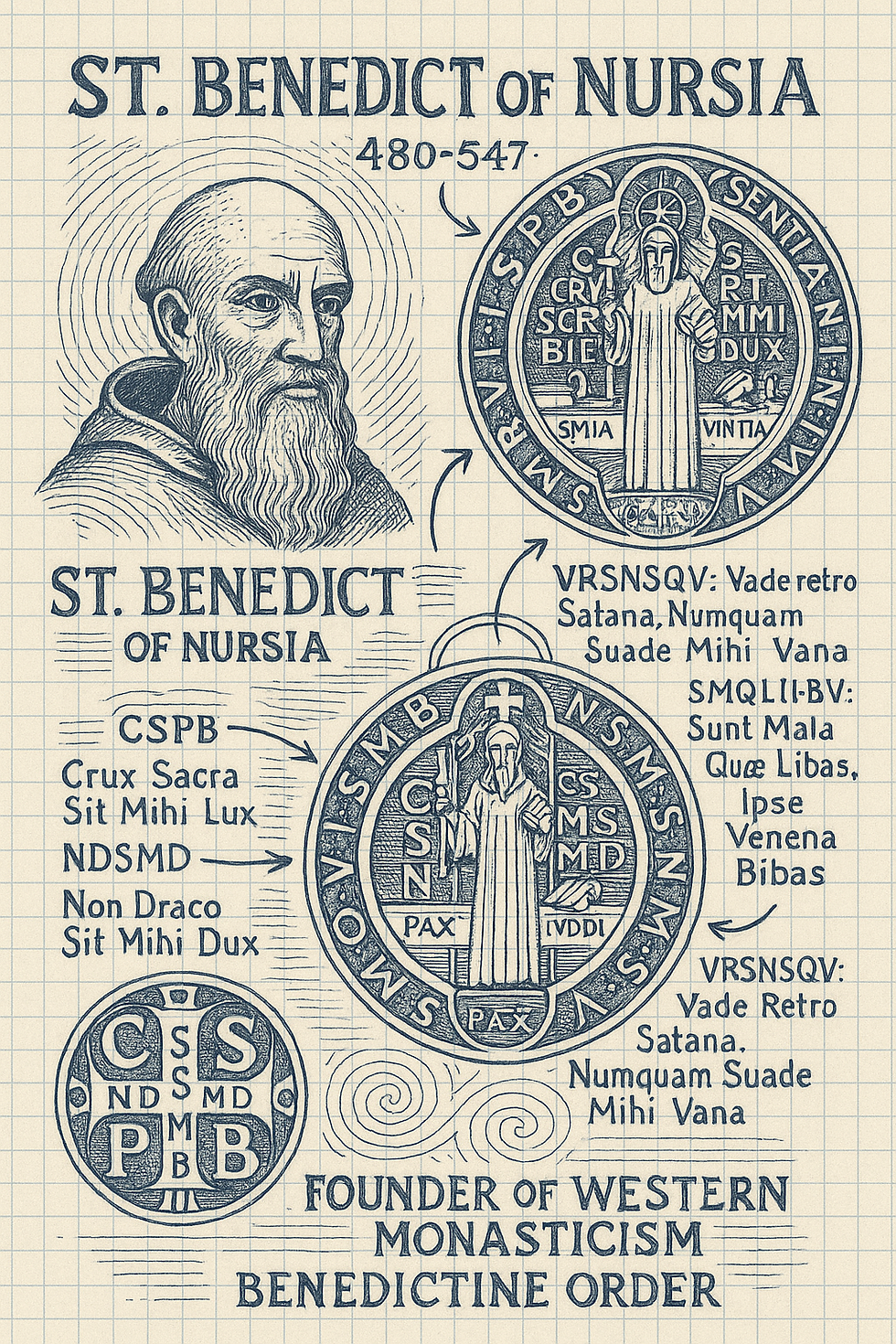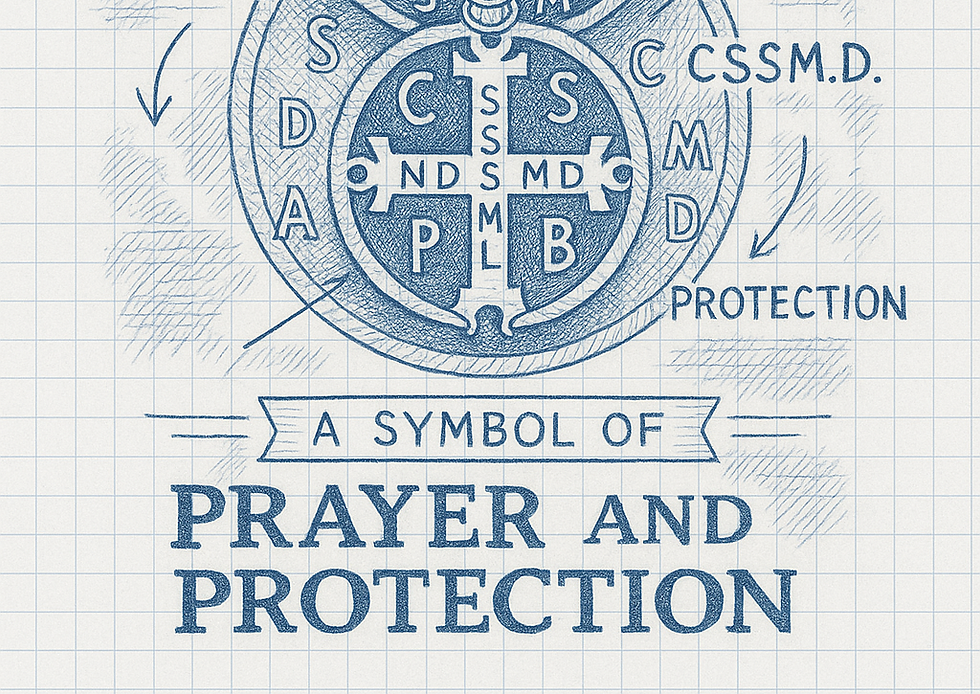Unraveling the Benedictine Medal: Symbols of Faith and Protection
- Fiach OBroin-Molloy

- Aug 20
- 4 min read
The Benedictine medal is one of the Church’s most powerful sacramentals — a compact masterpiece of spiritual symbolism that has been carried by monks, missionaries, and lay faithful for centuries. Every letter and image on this medal has meaning, forming a silent but constant prayer for God’s protection and guidance.

In this article, we’ll explore the medal’s history, decode its inscriptions, and share ways to incorporate it into your daily life.
A Brief History
The roots of the Benedictine medal trace back to the life of St. Benedict of Nursia (480–547), founder of Western monasticism and the Benedictine Order. St. Benedict became known for his wisdom, his Rule of life (The Rule of St. Benedict), and for the many miracles attributed to his intercession — especially in protection against evil.
Tradition holds that the medal, in its earliest form, emerged as a token of protection given to those entering Benedictine communities or embarking on journeys. Its present design dates to the 19th century, when Pope Pius IX approved the Jubilee Medal of St. Benedict in 1880 to mark the 1,400th anniversary of the saint’s birth.

Front of the Medal: The Saint and the Symbols
On the front of the medal, you’ll typically see:
St. Benedict Holding the Cross - The cross in his right hand represents Christ’s victory over sin and death — and the central place of the Cross in Benedict’s spirituality.
The Rule of St. Benedict - In his left hand, Benedict holds the open Rule, which has shaped monastic life for over 1,500 years.
A Cup and a Raven - On either side of the saint are two symbols from his life: the poisoned cup (which shattered when he blessed it) and the raven (which carried away poisoned bread intended to harm him). These images are reminders of divine protection.
Latin Inscription - Around the edge, the words Eius in obitu nostro praesentia muniamur! (“May we be strengthened by his presence in the hour of our death!”) — a prayer for Benedict’s intercession at life’s most important moment.
Back of the Medal: The Spiritual Code
The reverse side is even more intriguing, filled with letters that are abbreviations for Latin prayers of exorcism and protection.
The Cross in the Centre
Each arm of the cross bears a letter:
C S P B — Crux Sancti Patris Benedicti (“The Cross of our Holy Father Benedict”).
Around the Cross
Clockwise from top left:
C S S M L — Crux Sacra Sit Mihi Lux (“May the Holy Cross be my light”).
N D S M D — Non Draco Sit Mihi Dux (“Let not the dragon be my guide”).
In the Border Around the Medal
Beginning at the top:
V R S N S M V — Vade Retro Satana; Numquam Suade Mihi Vana (“Begone, Satan; do not suggest to me thy vanities”).
S M Q L I V B — Sunt Mala Quae Libas; Ipse Venena Bibas (“Evil are the things thou profferest; drink thou thy own poison”).
Together, these inscriptions form a continual prayer of protection against temptation, danger, and the influence of evil.
The Medal as a Sacramental
The Benedictine medal is not a magical charm; rather, it is a sacramental — a sign instituted by the Church to dispose the soul to receive grace. Its efficacy depends on the faith of the person wearing it and the blessing it receives.
When blessed by a priest (often using a special rite of exorcism and blessing), the medal becomes a powerful reminder of Christ’s victory and St. Benedict’s intercession.
Ways to Use the Benedictine Medal
Worn on a Chain or in a Pocket — As a personal sign of protection.
Attached to a Rosary — Many Benedictine rosaries include the medal in the centrepiece.
Placed in the Home or Car — To bless and protect a space.
Embedded in a Foundation Stone — A Benedictine tradition for consecrating a building.
Associated Prayers
Wearing or carrying the medal is often accompanied by prayers like:
“The Holy Cross be my light; let not the dragon be my guide.”
“Begone, Satan; suggest not to me thy vanities. Evil are the things thou profferest; drink thou thy own poison.”
Some also pray the Prayer of St. Benedict daily, asking for a heart detached from sin and fixed on God.
Why It Remains Relevant Today
In a world where anxiety, uncertainty, and spiritual battles feel ever-present, the Benedictine medal serves as a tangible connection to a centuries-old tradition of prayer and protection. It’s both a reminder of our Christian call to vigilance and a reassurance that God’s grace is stronger than any threat.

For many, carrying the medal is a way of saying daily:
“I belong to Christ. His Cross is my light.”
Final Reflection
The Benedictine medal is not just for monks or those in religious life. It is a gift for the entire Church — a portable icon of faith, discipline, and protection. Whether worn around the neck, tucked into a wallet, or placed in a home, it continues St. Benedict’s mission of guiding souls to God.
By learning its meaning, we’re reminded that faith is often expressed in the details: a few small letters, a simple cross, and a story that stretches back over a millennium can still speak powerfully into our lives today.








Comments